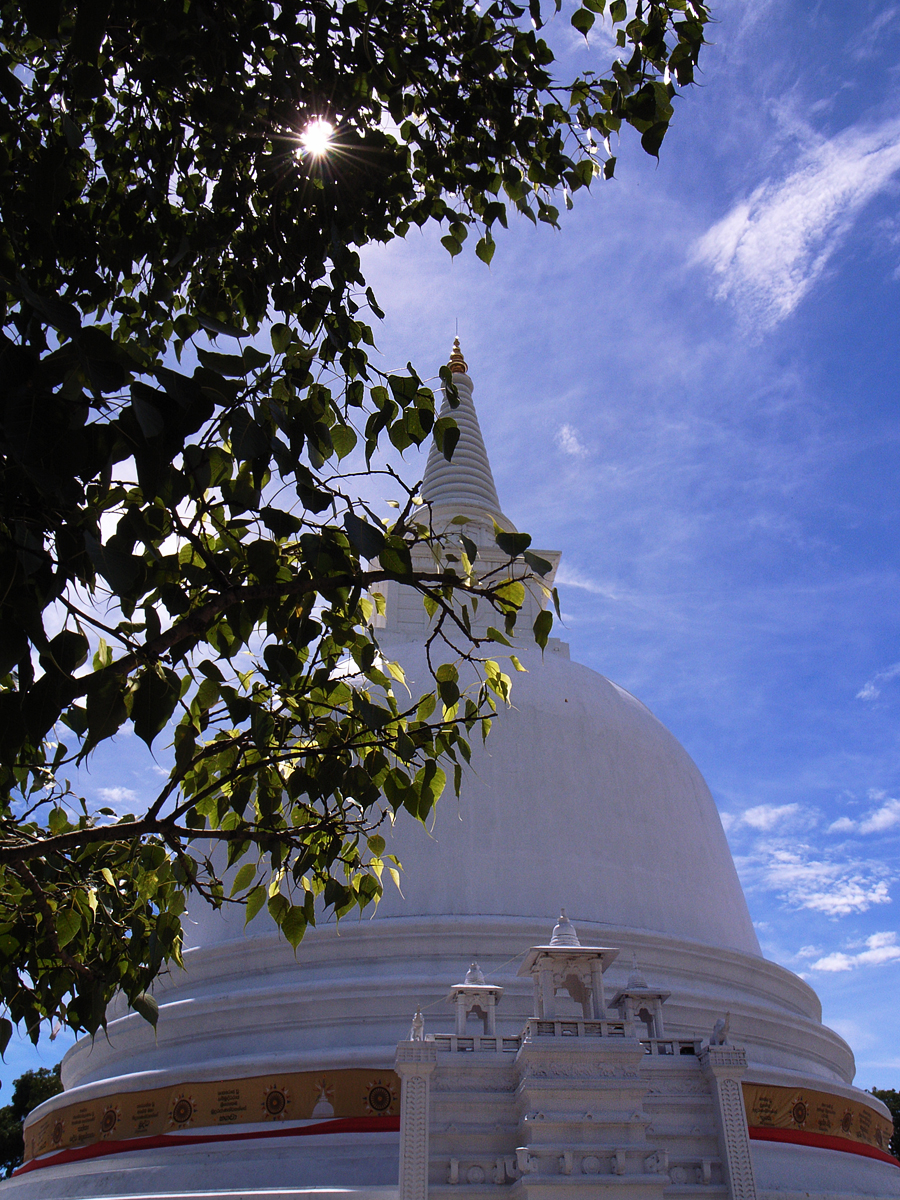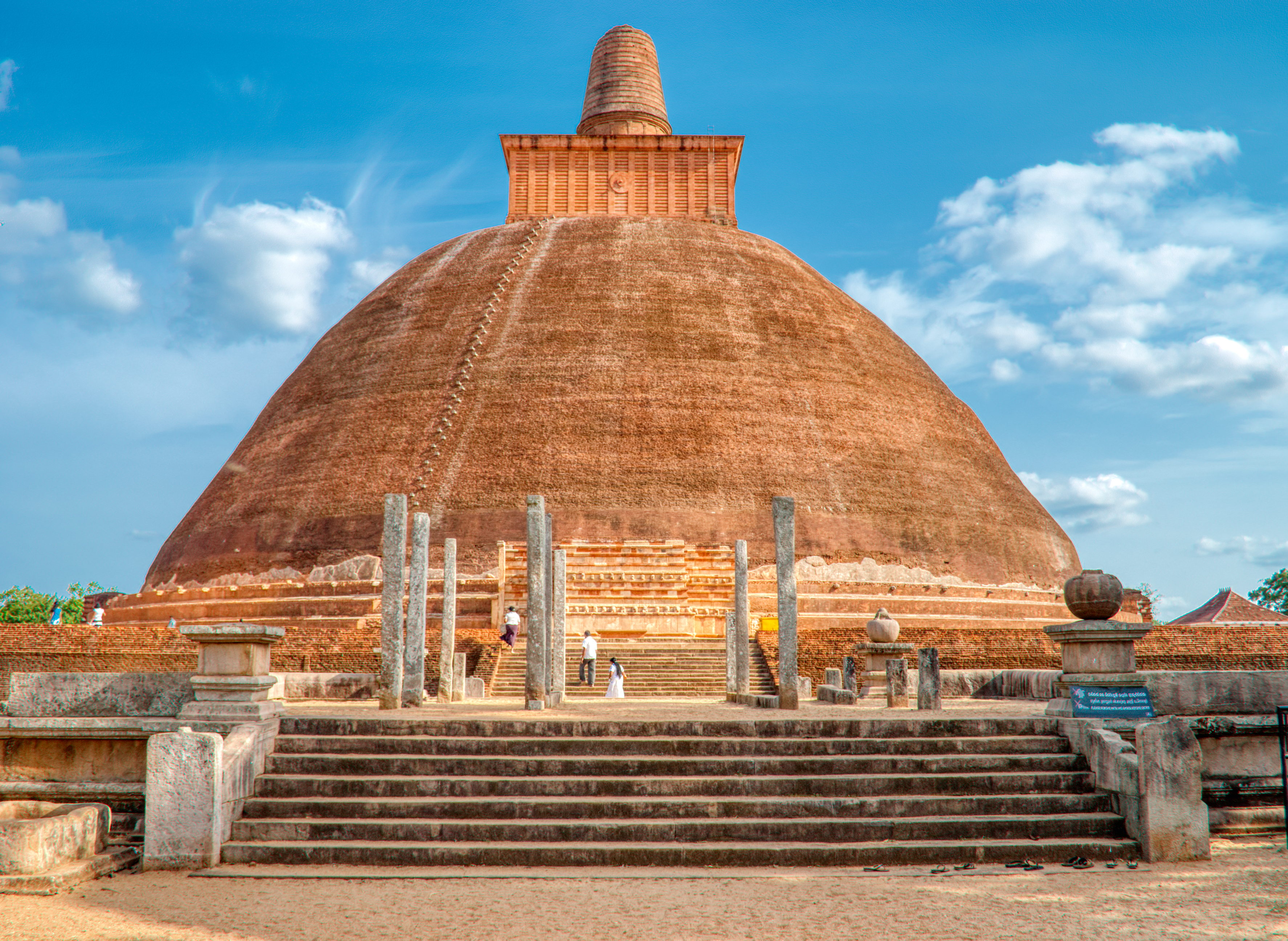|
Ruwanweliseya
The Ruwanweli Maha Seya, also known as the Mahathupa (), is a stupa (a hemispherical structure containing relics) in Anuradhapura, Sri Lanka. Two quarts or one Dona of the Buddha's relics are enshrined in the stupa, making it the largest collection of his relics anywhere. It was built by Sinhalese King Dutugemunu in 140 B.C., who became king of Sri Lanka after a war in which the Chola King Elāra (Ellalan) was defeated. It is also known as Swarnamali Seya, Svaṇṇamāli Mahaceti (in Pali) and Rathnamali Seya. This is one of the " Solosmasthana" (the 16 places of veneration) and the " Atamasthana" (the 8 places of veneration). The stupa is one of the world's tallest ancient monuments, standing at and with a circumference of . The original stupa had been about in height and was renovated by many kings. The Kaunghmudaw Pagoda in Sagaing, Myanmar is modelled after this stupa The Mahavamsa contains a detailed account on the construction and the opening ceremony of the stupa. ... [...More Info...] [...Related Items...] OR: [Wikipedia] [Google] [Baidu] |
Dutugemunu
Dutugamunu the Great (, , also spelled as ''Dutthagamani''), also known as Dutthagamani Abhaya ("fearless Gamini"), was the greatest king of the Anuradhapura Kingdom who reigned from 161 BC to 137 BC. He is renowned for reuniting the whole island of Sri Lanka by defeating and overthrowing Elara, the usurping Tamil prince from the Chola Kingdom, who had invaded the Anuradhapura kingdom in 205 BC. Dutugamunu also expanded and beautified the city of Anuradhapura and projected the power of his native Rajarata region across the island of Sri Lanka. Due to his significance as one of the most potent symbols of Sinhalese historical power, Dutugamunu's story is swathed in myth and legend. However, many aspects of the accounts of his life have been verified by contemporary inscriptions, and the basic account of his life is generally accepted as accurate. Etymology The Mahavamsa describes how as a youth he mocked his father Kavantissa, king of Ruhuna, for refusing to wage war against th ... [...More Info...] [...Related Items...] OR: [Wikipedia] [Google] [Baidu] |
Dutugamunu
Dutugamunu the Great (, , also spelled as ''Dutthagamani''), also known as Dutthagamani Abhaya ("fearless Gamini"), was the greatest king of the Anuradhapura Kingdom who reigned from 161 BC to 137 BC. He is renowned for reuniting the whole island of Sri Lanka by defeating and overthrowing Elara, the usurping Tamil prince from the Chola Kingdom, who had invaded the Anuradhapura kingdom in 205 BC. Dutugamunu also expanded and beautified the city of Anuradhapura and projected the power of his native Rajarata region across the island of Sri Lanka. Due to his significance as one of the most potent symbols of Sinhalese historical power, Dutugamunu's story is swathed in myth and legend. However, many aspects of the accounts of his life have been verified by contemporary inscriptions, and the basic account of his life is generally accepted as accurate. Etymology The Mahavamsa describes how as a youth he mocked his father Kavantissa, king of Ruhuna, for refusing to wage war against th ... [...More Info...] [...Related Items...] OR: [Wikipedia] [Google] [Baidu] |
Solosmasthana
'Solosmasthana' are 16 sacred places in Sri Lanka, believed by Buddhists to have been hallowed by visits of Gautama Buddha. These places of worship are among the most important religious locations in Sri Lanka, and are located throughout the country. Ancient Buddhist and historical sources of Sri Lanka assert that the Buddha visited the country on three occasions. These three visits are given in some detail in the ancient chronicle Mahavamsa, which describes his journeys to eleven of the Solosmasthana. Other sources such as the Pujavaliya, Samantapasadika and Butsarana also mention these visits. History The first visit was made to Mahiyangana in the ninth month after the Buddha attained enlightenment. The Mahavamsa says that he conquered the yakshas there and sent them to an island named Giri, thereby setting the background for the establishment of Buddhism in the country later on, where the Buddha knew that the Dhamma would prevail "in all its glory". The Buddha's second visit t ... [...More Info...] [...Related Items...] OR: [Wikipedia] [Google] [Baidu] |
Stupa
A stupa ( sa, स्तूप, lit=heap, ) is a mound-like or hemispherical structure containing relics (such as ''śarīra'' – typically the remains of Buddhist monks or nuns) that is used as a place of meditation. In Buddhism, circumambulation or '' pradakhshina'' has been an important ritual and devotional practice since the earliest times, and stupas always have a ''pradakhshina'' path around them. The original South Asian form is a large solid dome above a tholobate or drum with vertical sides, which usually sits on a square base. There is no access to the inside of the structure. In large stupas there may be walkways for circumambulation on top of the base as well as on the ground below it. Large stupas have or had ''vedikā'' railings outside the path around the base, often highly decorated with sculpture, especially at the torana gateways, of which there are usually four. At the top of the dome is a thin vertical element, with one of more horizontal discs sp ... [...More Info...] [...Related Items...] OR: [Wikipedia] [Google] [Baidu] |
Anuradhapura
Anuradhapura ( si, අනුරාධපුරය, translit=Anurādhapuraya; ta, அனுராதபுரம், translit=Aṉurātapuram) is a major city located in north central plain of Sri Lanka. It is the capital city of North Central Province, Sri Lanka and the capital of Anuradhapura District. The city lies north of the current capital of Colombo in the North Central Province, on the banks of the historic Malvathu River. The city is now a World Heritage Site famous for its well-preserved ruins of the ancient Sinhalese civilization. While Mahavamsa place the founding of the city in 437 BCE, the site has been inhabited for much longer, making it a major human settlement on the island for almost three millennia and one of the oldest continuously occupied cities in Asia. It is the cradle of the Hydraulic Sinhalese civilization, Theravada Buddhism, and the longest-serving ancient capital of Sri Lanka that has survived for 1500 years. Moreover, It was the first capi ... [...More Info...] [...Related Items...] OR: [Wikipedia] [Google] [Baidu] |
Rajarata
Rajarata ā dja ra tə(Meaning: King's country) ( Sinhala: රජරට) (Tamil: ரஜரட) was one of three historical regions of the island of Sri Lanka for about 1,700 years from the 6th century BCE to the early 13th century CE. Several ancient cities, including Tambapanni, Upatissa Nuwara, Anuradhapura and Polonnaruwa, were established as capitals within the area by successive rulers. Rajarata was under the direct administration of the King (raja/king, rata/country). Two other areas, Malayarata and Ruhunurata, were ruled by the king's brothers "Mapa" and "Epa" . The Magha invasion in the 13th century brought about the end of the Rajarata kingdom. History and kingdoms The first kingdom in Rajarata was established by Prince Vijaya in 543 BCE. He settled near the delta of the Malvathu River between Chilaw and Mannar. According o a local myth, Prince Vijaya married a local princess, Kuveni, to gain control of Rajarata. With her help, he betrayed and killed all of the regional ... [...More Info...] [...Related Items...] OR: [Wikipedia] [Google] [Baidu] |
Parakramabahu I
Parākramabāhu I ( Sinhala: මහා පරාක්රමබාහු, 1123–1186), or Parakramabahu the Great, was the king of Polonnaruwa from 1153 to 1186. He oversaw the expansion and beautification of his capital, constructed extensive irrigation systems, reorganised the country's army, reformed Buddhist practices, encouraged the arts and undertook military campaigns in South India and Burma. The adage "Not even a little water that comes from the rain must not flow into the ocean without being made useful to man" is one of his most famous utterances. In 1140, Parakramabahu following the death of his uncle, Kitti Sri Megha, Prince of Dakkinadesa, ascended the throne of Dakkhinadesa. Over the next decade, improved both Dakkhinadesi infrastructure and military. Following a protracted civil war, he secured power over the entire island around 1153 and remained in this position until his death in 1186. During Parākramabāhu's reign, he launched a punitive campaign against ... [...More Info...] [...Related Items...] OR: [Wikipedia] [Google] [Baidu] |
Tamil Nadu
Tamil Nadu (; , TN) is a state in southern India. It is the tenth largest Indian state by area and the sixth largest by population. Its capital and largest city is Chennai. Tamil Nadu is the home of the Tamil people, whose Tamil language—one of the longest surviving classical languages in the world—is widely spoken in the state and serves as its official language. The state lies in the southernmost part of the Indian peninsula, and is bordered by the Indian union territory of Puducherry and the states of Kerala, Karnataka, and Andhra Pradesh, as well as an international maritime border with Sri Lanka. It is bounded by the Western Ghats in the west, the Eastern Ghats in the north, the Bay of Bengal in the east, the Gulf of Mannar and Palk Strait to the south-east, and the Indian Ocean in the south. The at-large Tamilakam region that has been inhabited by Tamils was under several regimes, such as the Sangam era rulers of the Chera, Chola, and Pandya ... [...More Info...] [...Related Items...] OR: [Wikipedia] [Google] [Baidu] |
Ancient Stupas Of Sri Lanka
Stupas, also called and cetiyas, are considered an outstanding type of architectural creation of ancient Sri Lanka. Under the influence of Buddhism, there were several changes in the field of architecture in Sri Lanka. The stupa commands a prominent place among these changes. The Stupa is also known by synonymous names such as Chaithya, Dagaba, Thupa, Seya and Vehera. Stupas designed and constructed in Sri Lanka are the largest brick structures known to the pre-modern world.Silva, R. 1990, "Bricks – A unit of construction in ancient Sri Lanka", ICTAD Journal, Vol.2, No. 1, pp. 21-42, Colombo. After Rev. Mahinda thero introduced Buddhism during the reign of King Devanampiya Tissa of Anuradhapura (307267 BCE), in the Sri Lanka’s ancient sacred capital of Anuradhapura, the king built the Anuradhapura Maha Viharaya, a mahavihara, after dedicating the Nandana and Mahamega royal pleasure gardens to the Maha Sangha. The earliest monument found in Sri Lanka is the Stupa, which is des ... [...More Info...] [...Related Items...] OR: [Wikipedia] [Google] [Baidu] |
List Of Tallest Structures Built Before The 20th Century
List of pre-twentieth century structures by height See also * History of the tallest buildings in the world References {{Tallest buildings and structures Ancient structures Tallest ancient structures History of construction ... [...More Info...] [...Related Items...] OR: [Wikipedia] [Google] [Baidu] |
Architecture Of Ancient Sri Lanka
The architecture of ancient Sri Lanka displays a rich diversity, varying in form and architectural style from the Anuradhapura Kingdom (377 BC–1017) through the Kingdom of Kandy (1469–1815). Sinhalese architecture also displays many ancient North Indian influences. Buddhism had a significant influence on Sri Lankan architecture after it was introduced to the island in the 3rd century BC, and ancient Sri Lankan architecture was mainly religious, with more than 25 styles of Buddhist monasteries.Pieris K (2006), Architecture and landscape in ancient and medieval Lanka Significant buildings include the stupas of Jetavanaramaya and Ruwanvelisaya in the Anuradhapura kingdom and further in the Polonnaruwa Kingdom (11th–13th centuries). The palace of Sigiriya is considered a masterpiece of ancient architecture and ingenuity, and the fortress in Yapahuwa and the Temple of the tooth in Kandy are also notable for their architectural qualities. Ancient Sri Lankan architecture is also ... [...More Info...] [...Related Items...] OR: [Wikipedia] [Google] [Baidu] |





